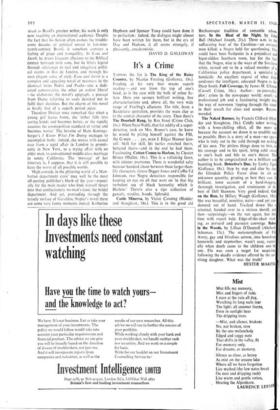It's a Crime
TOPPING the list is The King of the Rainy Country, by Nicolas Freeling (Gollancz, 18s.). Freeling at his very best means superb reading — and not from the top of one's head, as is the case with the bulk of crime fic- tion. Here one savours brilliant writing, fine characterisations and, above all, the very wide range of Freeling's allusions. The title, from a Baudelaire quotation, provides the main clue as to the central character of the story. Then there's The Doorbell Rang, by Rex Stout (Crime Club, 16s.). When Nero Wolfe, that fat oddity of a super- detective, took on Mrs. Bruner's case, he knew he would be pitting himself against the FBI, the G-men . . . yes, even J. Edgar Hoover him- self. Skill for skill, his tactics matched theirs, bettered theirs—and in the end he had them. Fascinating. Cotton Comes to Harlem, by Chester Himes (Muller, 18s.). This is a rollicking farce, with sinister overtones. There is wonderful salty humour bandied about between those larger-than- life characters, Grave Digger Jones and Coffin Ed Johnson, two Negro detectives responsible for keeping an eye on all that went on 'in that big turbulent sea of black humanity which is Harlem.' There's also a ripe collection of gunsels, stoolies, hoods. Splendid.
Castle Minerva, by Victor Canning (Hodder and Stoughton, 18s.). This is in the good old Buchanesque tradition of romantic adv. hare. In the Heat of the Night, by John Ball (Michael Joseph, 21s.). Three a.m. in the suffocating heat of the Carolinas—an eminent man killed; a Negro held for questioning. This could have been flashpoint in a prejudiced and bigot-ridden Southern town, but for the fact that the Negro, wise in the ways of the Southern white, turned out to be a valued member of a Californian police department, a specialist in homicide. An excellent expose of what daily confronts the intelligent, educated Negro in the Deep South. Full Coverage, by James M. Ullman (Cassell Crime, 16s.). Author : ex-journalist; plot : crime in the newspaper world; result: a professional job and a fascinating insight into the way of newsmen 'ripping through the town' in their search for clues and scoops. Recoto. mended.
The Naked Runner, by Francis Clifford (Hod. der and Stoughton, 18s.). Coldly sober writing, with a bone-chilling effect, all the more so because the account set down is so credible and so possible. Here is a story of a man—no spy— who is truly out in the cold through no seeking of his own. The pitiless things done to him, to his courage and to his spirit, bring cold sweat to one's back and bile to one's throat The author is to be congratulated on a brilliant and haunting book. Detective's Due, by Lesley Egan (Gollancz, 18s.). Step by step and clue by clue the Glendale Police Force close in on an unknown quantity, groping as best they can. A brilliant, tense account of a hard-slogging, thorough investigation, and reminiscent of the best of Dell Shannon. Very good indeed. Cid on the Run, by Hillary Waugh (Gollancz, 18s.). She was beautiful, sensitive, naive—and yet con• demned out of hand. Tracked down like a criminal, handed over to a vicious sheriff, and then—surprisingly--on the run again, but this time with expert help. Edge-of-the-chair read. ing, as pursued and pursuers converge. Babes in the Woods, by Lillian O'Donnell (Abelard. Schuman, 15s.). The metamorphosis of Flo Avery, gay and frivolous actress, into humdrum housewife and stepmother, wasn't easy, especi- ally when death came to the children one by one. Flo was soon a target for suspicion, following the deadly evidence offered by the sup viving daughter. What was the truth?
HESTER MAKEIG






































 Previous page
Previous page